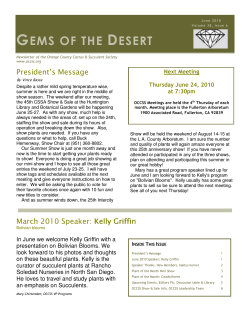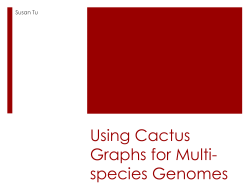
JUNE PROGRAM - Sacramento Cactus and Succulent Society
Thorny Issues Sacramento Cactus & Succulent Society June 2015 | Volume 56, VI JUNE PROGRAM JoEllen by Lenore Ralston Next Meeting MONDAY June 22 Our next meeting on Monday, June 22, will feature a special presentation by our club’s own JoEllen Arnold. Join JoEllen on a small boat cruise through the Galapagos Islands, where we will visit the fascinating flora and fauna of these desert islands which lie on the equator off the coast of Ecuador. They are home to cactus species which provide food and shelter to many of the endemic species of animals on the islands, none of which are shy around humans. Expect close encounters with sea lions, marine and land iguanas, penguins and pelicans, mockingbirds, finches, albatross and boobies, and of course, the giant tortoises for which the Galapagos Islands are named. These photos are just a teaser of what you will see! —Gerhard Bock, Program Chair JUNE SUCCULENT AND CACTUS MINI SHOW Mini Show Descriptions by Steve Goodman. Photos by Gerhard Bock Even though the Mini Show Master schedule says June succulent is Stapelia I have decided to include 2 other genera, Hoodia and Huernia. The genera of plants within the tribe Stapeliae are all to varying degrees stem succulents. Many of the species resemble cacti, though are not closely related, as an example of convergent evolution. The stems are often angular, mostly four-angled in cross-section, but in some species there are six or more, with some species of Hoodia having more than thirty angles. In size they vary from less than 2.5 cm/1” in length to over 2 m/6” tall. The leaves are in most species reduced to rudiments, sometimes hardened and thornlike, arranged on bumps or tubercles on the angles. Stapeliads are most abundant in warm, dry climates. In Africa, there are two separate regions where Stapeliads have most diversified: northeast Africa, and Southern Africa. Several species are endemic to the small island of Socotra off the Horn of Africa. The Arabian Peninsula, and most specifically the country of Yemen, contain another concentration of species. Several more are found in the drier parts of Pakistan, Afghanistan, India, Nepal, and Myanmar. Most Stapeliads use flies as pollina- Toad cactus (Orbea variegata) Succulent • STAPELIA / HUERNIA / HOODIA tors, that are attracted to odours resembling dung or rotting meat, emanating from the flowers leading to the common name of carrion flower. However, not all Stapeliads smell bad, or attract flies. Some species use beetles, bees, wasps, butterflies or moths as pollinators. Stapeliad flowers range in size from mere millimetres in species of Echidnopsis and Pseudolithos to those of Stapelia gigantea that can reach 40 cm/16” in diameter, and are some the largest of flowers to be found on any species of succulent. MAY SUCCULENT & CACTUS MINI SHOW WINNERS SUCCULENT: ANY GRAFTED 1st: Euphorbia lactea crest, Steve Goodman 2nd: Euphorbia lactea crest, Michelle Egan CACTUS: ANY GRAFTED 1st: Ceres species crest, Michelle Egan 2nd: Gymnocalycium mihanovichii ‘Hibotan’, Steve Goodman PUNCTURE THUMB AWARD If you missed the Potluck on May 20, you missed the opportunity to see an almost speechless Michelle Egan as she accepted this year’s Punctured Thumb Award. Congratulations, Michelle, on all your hard work for the club. -From the club board. Cactus • REBUTIA & SULCOREBUTIA Rebutia and Sulcorebutia were long considered to be separate genera but they are now generally considered to both be in the genus Rebutia. There are now around 60 species of Rebutia and/or Sulcorebutia cactus native to the eastern side of the Andes Mountains in Bolivia and Northern Argentina. They are generally small globular cacti, 4 inches in diameter or less (10 cm). Many species form large clusters. The genus Rebutia is named after P. Rebut, French cactus dealer and expert from the 19th century. Rebutias bloom easily and have relatively large daytime flowers. Flowers are generally yellow to red, although some species have white ones. They come Rebutia krainziana from the lower part of the stem. Optimal growing conditions vary. In this regard the old names are quite useful since they give some ideas of what to expect. All the species need a gritty, well drained, slightly acidic cactus soil. They also need strong light, although generally not too much direct sunlight. They need good watering in summer, but you should allow the soil mixture to dry out between watering. The plants from the original genus Rebutia are fairly cold resistant and will take some frost. The Sulcorebutia on the other hand are generally less cold resistant and more prone to overwatering. Rebutia are propagated by seed or offsets. The seeds should be less than 12 months old. Sulcorebutia bicolor ANNUAL COUNTRY STORE COMING SEPTEMBER! Country Store Update: Wow, with the hot weather, our garden is growing like gangbusters. If you have bushels of produce and are thinking about making jams, relishes, canned tomatoes, etc., put up an extra jar or two for the Country Store Produce Table. Keep rooting those cuttings for the Cacti and Succulent Tables. Staying indoors and cleaning closets? Save your extraneous cacti/succulent themed items for the Silent Auction. All this happens at the September meeting! –Marilynn Vilas, Chair SUNSHINE REPORT Sunshine: Know someone in the club under the weather (Aren’t we all with this heat!). Let Marilynn Vilas know so she can send a cheerup card. She can be reached by email or telephone (see roster). 50th ANNUAL CSSA SHOW & SALE HUNTINGTON BOTANICAL GARDENS Friday June 26-28th. 1151 Oxford Road, San Marino, CA. Friday, 9:00 am –4:00 p.m Show and Sale: Sat. 10:30 am to 4:30, Sun. 10:30 to 4:00 pm Hundreds of award-winning plants will be on view as the Cactus and Succulent Society of America presents its 50th annual show and sale. Rare specimens from around the world will be showcased, including plants native to Mexico, Chile, Argentina, Botswana, Madagascar, and the Middle East. The juried competition will also include categories for photography, paintings, crafts, and dish gardens. Plants and related items will be available for sale both days, Friday, noon–4:30 p.m. Friends’ Hall. MAY SHOW SCHEDULE UPDATE The May Show Committee would like to update and possibly redo the plant registration schedule to be more current and user-friendly. If you have any ideas and/or suggestions, please convey to Marilynn Vilas. MONTHLY RAFFLES For those new members! Every meeting we have a fun raffle of various cactus and succulents. Buy your tickets at the beginning of the meeting to try your chance on some great succulents to add to your growing garden! SCSS MEMBERSHIP Thank you succulent enthusiasts for renewing your membership! New guests are invited to join! Dues in the Society are $15 per person and $20 per family membership for one calendar year. MAKE CHECKS PAYABLE TO: SCSS (Sacramento Cactus & Succulent Society) MAIL TO: Ginger Martin, 9199 Locust St., Elk Grove CA 95624 Questions: 916-685-1032 or gingermartin@mac.com SACRAMENTO CACTUS & SUCCULENT SOCIETY Next Meeting Monday June 22, 7:00pm Shepard Garden & Arts Center 3330 McKinley Blvd Sacramento, CA 95816 center phone: (916) 808-8800 www.sacramentocss.org For publication submissions email: succulentcrazy@gmail.com by the 5th of the month
© Copyright 2025










